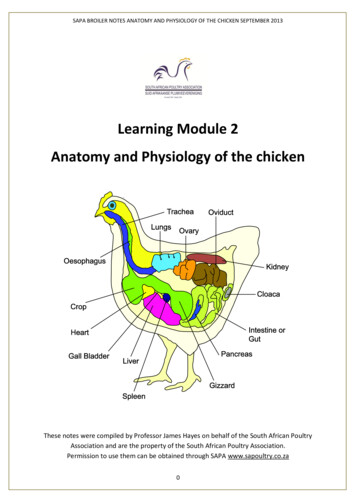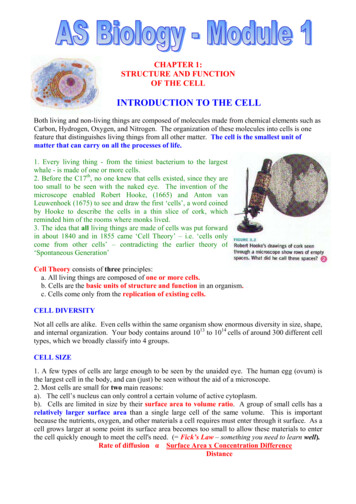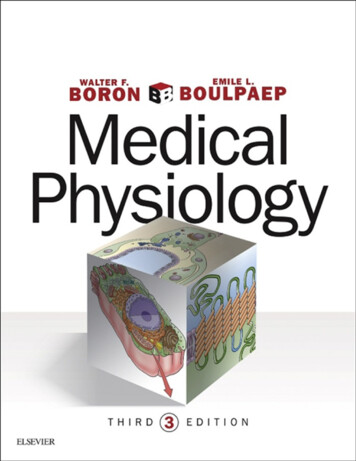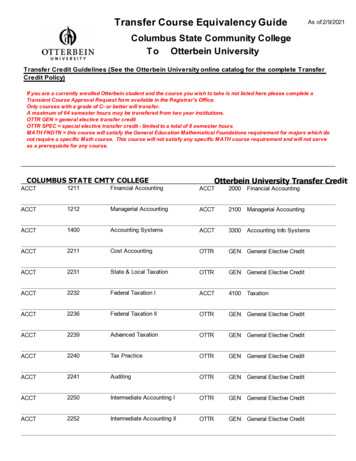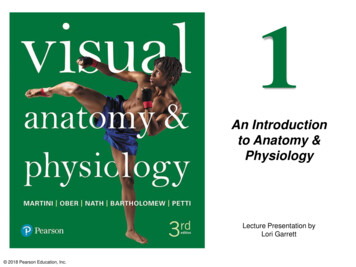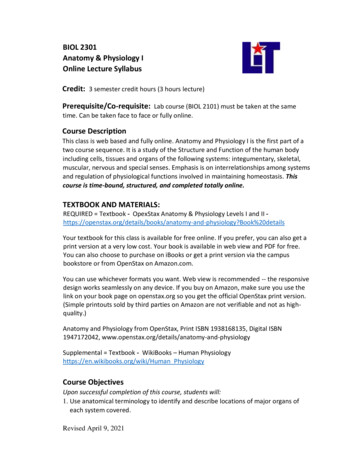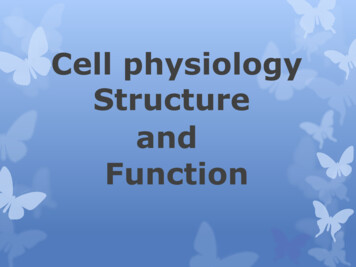
Transcription
Cell physiologyStructureandFunction
Introduction to the cell biology What is a Cell ? Cells : are the microscopic fundamental units of allliving things. Every living thing has cells: bacteria, protozoans,fungi, plants, and animals are the main groups(Kingdoms) of living things. Some organisms are made up of just one cell (e.g.bacteria and protozoans). But animals, including human beings, aremulticellular. An adult human body is composed of about 100trillion cells! Each cell has basic requirements tosustain it. and the body's organ systems are largelybuilt around providing the many trillions of cells withthose basic needs (such as oxygen, food, and wasteremoval).
Introduction to the cell biology About 200 different types of specialized cells carry out amultitude of functions that help each system contribute to thehomeostasis of the entire body. At the same time, all cells share key structures and functions thatsupport their intense activity. For ease of study, we divide the cell into three main parts:1. plasma membrane2. cytoplasm3. nucleus
Human Cell, Structure andFunctions: The cell : is the basic functional in a human meaning thatit is a self-contained and fully operational living entity.Humans are multicellular organisms with variousdifferent types of cells that work together to sustain life.Other non-cellular components in the body includewater, macronutrients (carbohydrates, proteins, lipids),micronutrients (vitamins, minerals) and electrolytes.A collection of cells that function together to perform thesame activity is known as tissue. Masses of tissue workcollectively to form an organ that performs specificfunctions in the body. Despite this structuralorganization, all activity boils down to the cell – acomplex unit that makes life possible.
Parts of the Human CellThe cell contains various structural components toallow it to maintain life which are known as organelles.All the organelles are suspended within a gelatinousmatrix, the cytoplasm, which is contained within thecell membrane. One of the few cells in the human bodythat lacks almost all organelles are the red blood cells .The main organelles are as follows :NucleusCell membraneEndoplasmic reticulumGolgi ments and microtubules.
NucleusThe nucleus : is the master control of the cell. Itcontains genes, collections of DNA, whichdetermines every aspect of human anatomy andphysiology. The DNA which is arranged intochromosomes also contains the blueprint specificfor each type of cell which allows for replication ofthe cell. Within the nucleus is an area known asthe nucleolus. It is not enclosed by a membranebut is just an accumulation of RNA and proteinswithin the nucleus. The nucleolus is the sitewhere the ribosomal RNA is transcribed from DNAand assembled.
Cell Membrane:The cell membrane is the outer coating of the celland contains the cytoplasm, substances within it andthe organelle. It is a double-layered membranecomposed of proteins and lipids. The lipid moleculeson the outer and inner part (lipid bilayer) allow it toselectively transport substances in and out of thecell.Endoplasmic Reticulum:The endoplasmic reticulum (ER) is a membranousstructure that contains a network of tubules andvesicles. Its structure is such that substances canmove through it and be kept in isolation from therest of the cell until the manufacturing processesconducted within are completed. There are two typesof endoplasmic reticulum – rough (granular) andsmooth (a granular).
The cytoplasm : consists of all the cellular contents between theplasma membrane and the nucleus. This compartment has two components: cytosol العصارة الحيوية and organelles العضيات .1. Cytosol : means the fluid portion of cytoplasm. Contains:(water, dissolved solutes, andsuspended particles). Surrounded by cytosol areseveral different types oforganelles (littleorgans). Each type of organelle has a characteristicshape and specific functions. Examples include: ( the cytoskeleton , ribosomes , endoplasmicreticulum , Golgi complex , lysosomes ,peroxisomes , and mitochondria )
Golgi ApparatusThe Golgi apparatus :is a stacked collectionof flat vesicles. It is closely associated withthe endoplasmic reticulum in thatsubstances produced in the ER aretransported as vesicles and fuses with theGolgi apparatus. In this way, the productsfrom the ER are stored in the Golgiapparatus and converted into differentsubstances that are necessary for the cell’svarious functions.
LysosomesLysosomes: are vesicles that break off from the Golgiapparatus. It varies in size and function depending onthe type of cell. Lysosomes contain enzymes that helpwith the digestion of nutrients in the cell and breakdown any cellular debris or invading microorganismslike bacteria.A structure that is similar to a lysosome isthe secretory vesicle. It contains enzymes that arenot used within the cell but emptied outside of the cell,for example the secretory vesicles of the pancreaticlacunar cell release digestive enzymes which helpwith the digestion of nutrients in the gut.
PeroxisomesThese organelles are very similar to thelysosomes and contain enzymes that acttogether in the form of hydrogen peroxide toneutralize substances that may be toxic tothe cell. Peroxisomes are formed directlyfrom the endoplasmic reticulum ratherthan from the Golgi apparatus likelysosomes.
MitochondriaThese are the powerhouses of the cell and break downnutrients to yield energy. Apart from producing its ownenergy, it also produces a high-energy compound called ATP(adenosine triphosphate) which can be used as a simpleenergy source elsewhere. Mitochondria are composed of twomembranous layers – an outer membrane that surrounds thestructure and an inner membrane that provides the physicalsites of energy production. The inner membrane has many infolding that form shelves where enzymes attach and oxidizenutrients. The mitochondria also contain DNA which allows ittoreplicatewhereandwhennecessary.
Mitochondria
Microfilaments and MicrotubulesMicrofilaments and microtubules are rigidprotein substances that form the internalskeleton of the cell known as the cytoskeleton.Some of these microtubules also make upthe centrioles and mitotic spindles within thecell which are responsible for the division of thecytoplasm when the cell divides. Themicrotubules are the central component of cilia,small hair-like projections that protrude from thesurface of certain cells. It is also the centralcomponent of specialized cilia like the tail of thesperm cells which beats in a manner to allow thecell to move in a fluid medium.
Functions of the Human Cell The functions of the human cell varies based on thetype of cell and its location in the human body.All the organelles work together to keep the cell aliveand allow it to carry out its specific function.Sometimes these organelles are highly specialized andcan vary in (size, shape and number).The organelles are the most basic functional units butit cannot exist and operate without the cell as a whole.Its functions include intake of nutrients and othersubstances, processing of these compounds,production of new substances, cell replication andenergy production. In specialized cells that need to bemotile, like sperm cells, tail-like projections allow forcellular locomotion.
Functions of the Human Cell The function of each organelle has already been discussed but isworth considering in summary:The cell membrane allows substances to enter and leave thecell.While certain substance like oxygen can easily diffuse throughthe cell membrane, others have to actively transported throughthe process of endocytosis. Small particles are transported bythe process of pinocytosis while larger particles are moved bythe process of phagocytosis. These functions can become highlyspecialized to allow cells to perform specific activities, like themacrophages that phagocytosis invading bacteria to neutralizeit.Small and large substances that do not dissolve in thecytoplasm are contained within vesicles. Lysosomes attach tothe vesicles and digest this material.The endoplasmic reticulum (ER) and Golgi apparatus synthesizedifferent substances like protein and fats as required by the cellor designated according to its specific function. It utilizes basicnutrient molecules that are either dissolved in the cytoplasm orspecific substances contained within vesicles .
Type of transporting in cell membrane EndocytosisEndocytosis (endo internal, cytosis transport mechanism) is ageneral term for the various types of active transport that moveparticles into a cell by enclosing them in vesicle made out of plasmamembrane.There are variations of endocytosis, but all follow the same basicprocess. First, the plasma membrane of the cell invaginates (foldsinward), forming a pocket around the target particle or particles. Thepocket then pinches off with the help of specialized proteins, leaving theparticle trapped in in a newly created vesicle or vacuole inside the cell.Endocytosis can be further subdivided into the following categories:phagocytosis, pinocytosis, and receptor-m1. PhagocytosisPhagocytosis (literally, “cell eating”) is a form of endocytosis in whichlarge particles, such as cells or cellular debris, are transported into thecell. We’ve already seen one example of phagocytosis, because this isthe type of endocytosis used by the macrophage in the article opener toengulf a pathogen.
Type of transporting in cell membrane2- Pinocytosis:Pinocytosis (literally, “cell drinking”) is a form ofendocytosis in which a cell takes in small amounts ofextracellular fluid. Pinocytosis occurs in many celltypes and takes place continuously, with the cellsampling and re-sampling the surrounding fluid toget whatever nutrients and other molecules happento be present. Pinocytosed material is held in smallvesicles, much smaller than the large food vacuoleproduced by phagocytosis.
Type of transporting in cell membraneExocytosisCells must take in certain molecules, such as nutrients,but they also need to release other molecules, such assignaling proteins and waste products, to the outsideenvironment.Exocytosis (exo external, cytosis transportmechanism) is a form of bulk transport in whichmaterials are transported from the inside to the outsideof the cell in membrane-bound vesicles that fuse withthe plasma membrane.
https://www.youtube.com/watch?v o2abDVq4M84
THANK YOUFORLISTENING
Introduction to the cell biology What is a Cell? Cells : are the microscopic fundamental units of all living things. Every living thing has cells: bacteria, protozoans, fungi, plants, and animals are the main groups (Kingdoms) of living things. Some organisms are made up of just

